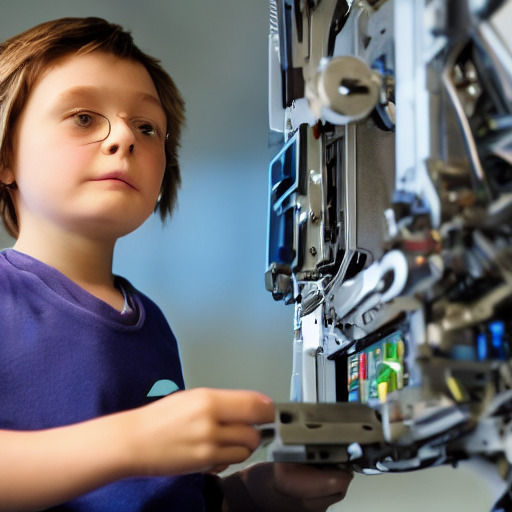
Machines, Are They Smarter Than a Six-Year-Old?
via AI.Nony.Mous
Researchers at USC Viterbi’s Information Sciences Institute are developing an algorithm that teaches machines to learn without human supervision.
“Generally speaking, machine learning is the science of teaching machines to act similar to humans,” said Mohammad Rostami, Research Lead at USC Viterbi’s Information Sciences Institute (ISI). Teaching machines to learn without any supervision by humans is the subject of his latest paper, Overcoming Concept Shift in Domain-Aware Settings through Consolidated Internal Distributions, which he will present at the 37th AAAI Conference on Artificial Intelligence, held in Washington, D.C. on Feb. 7-14, 2023.
Rostami explained how machine learning is typically done: “We collect data that is annotated by humans, and then we teach the machine how to act similar to humans given that data. The problem we encounter is that the knowledge the machine obtains is limited to the data set that was used for training.” Additionally, the data set used for training is often not available after the training process is complete.
The resulting challenge? If the machine receives input that is different enough from the data it was trained on, the machine gets confused and will not act similar to a human.
A Bulldog or a Shih Tzu or Something Else Entirely?
Rostami offered an example, “There are many categories of dogs, different types of dogs are visually not very similar, and the variety is significant. If you train a machine to categorize dogs, its knowledge is limited to the samples that you used for training. If you have a new category of dog that is not among the training samples, the machine is not going to be able to learn that it’s a new type of dog.”
Interestingly, humans are better at this than machines. When humans are given something to categorize, if they are given just a few samples in a new category (i.e., a new breed of dog), they adjust and learn what that new category is. Rostami said, “a six-year-old child can learn a new category using two, three, or four samples, as opposed to most modern machine learning techniques which require at least several hundred samples to learn that new category.
Categorizing in the Face of Concept Shift
Often, it’s not about learning entirely new categories, but being able to adjust as existing categories change.
If a machine learns a category during training, and then over time it undergoes some changes (i.e., the addition of a new subcategory), Rostami hopes that with his research, the machine will be able to learn or extend the notion of what that category is, (i.e., to include the new subcategory).
The changing nature of a category is what is known as “concept shift.” The concept of what a category is shifts over time. Rostami offered another real-world example: the spam folder.
He explained, “Your email service has a model to categorize your inbox emails into legit emails and spam emails. It is trained to identify spam using certain features. For example, if an email is not addressed to you personally, it is more likely that it’s spam.”
Unfortunately, spammers are aware of these models and constantly add new features in order to trick the models, to prevent their emails from being categorized as spam.
Rostami continued, “this means that the definition of ‘spam’ changes over time. It is a time dependent definition. The concept is the same – you have the concept of ‘spam’ – but over time the definition and details about the concept change. That’s concept shift.”
A New Way to Train
In his paper, Rostami has developed a method for training a machine learning model that addresses these issues.
Because original training data is not always available, Rostami’s method does not rely on that data. Co-author and ISI Principal Scientist Aram Galstyan explained how, “The model learns the distribution of the old data in the latent space, then it can generate latent representation, almost like generating a synthetic data set by learning the representation of the old data.”
Because of this, the model can retain what was learned in the initial training phase, which allows it to adapt and learn new categories and subcategories over time.
It also, importantly, means it will not forget the original training data or what it learned from it. This is a major issue in machine learning. Galstyan explained, “When you train a new model, it can forget about some patterns that were useful before. This is known as catastrophic forgetting,” said Galstyan.
With the approach developed in this paper, Galstyan said “catastrophic forgetting is implicitly addressed because we introduce a correspondence between the old distribution of data and the new one. So, our model will not forget the old one.”
What’s Next?
Rostami and Galstyan are pleased with the results, especially because it does not rely on the availability of source data. Galstyan said, “I was pleasantly surprised to see that the model compares favorably to most of the state-of-the-art existing baselines.”
Rostami and Galstyan plan to continue their work on this concept and apply the proposed method on real-world problems.
But first, Rostami will present the research and findings at the upcoming 37th AAAI Conference on Artificial Intelligence. Run by the largest professional organization in the field, the AAAI conference aims to promote research in artificial intelligence and scientific exchange among AI researchers, practitioners, scientists, and engineers in affiliated disciplines. This year, the conference had an acceptance rate of 19.6%.
One Final Highlight
In addition to presenting this paper, Rostami has been selected for the AAAI ‘23 New Faculty Highlight speaker program, which features promising AI researchers who have just begun careers as new faculty members. Rostami, who became a USC faculty member in July 2021, will give a 30-minute talk about his research to date and his vision for the future of AI. The program, which is highly competitive, typically includes fewer than 15 new faculty based largely on the promise and impact of their research to-date (e.g., publications in top-tier forums, citations, awards, or deployed systems) and their future plans.
Original Article: Machines, Are They Smarter Than a Six-Year-Old?
More from: University of Southern California Viterbi School of Engineering
The Latest Updates from Bing News
Go deeper with Bing News on:
Machines learning without human supervision
- Banks told to anticipate risks from using AI, machine learning
Banks must anticipate risks from using artificial intelligence (AI) and machine learning (ML) in their operations as part of their day-to-day governance, a top global banking regulator said on ...
- 13 Best Machine Learning Stocks To Invest In
The concepts of machine learning ... without explicit programming. On the other hand, artificial intelligence includes a broader range of techniques that aim to create systems capable of human ...
- AI and Machine Learning will not save the planet (yet)
The rush to ‘AI everything’ is producing a tremendous amount of wasted energy, with 14,000 AI startups currently in existence, how many will actually produce tools that will benefit humanity?
- Machines Cannot Replace Human Boredom
At first, the devices appear to function flawlessly without any oversight, but upon further reflection, the artworks emphasize the necessity of human intelligence in the future of labor.
- machine learning
On Monday, OpenAI announced that visitors to the ChatGPT website in some regions can now use the AI assistant without signing ... using small cameras and machine-learning algorithms to detect ...
Go deeper with Bing News on:
Concept shift
- From German Shepards To Beagles: A Paradigm Shift In Dog Adoption Trends In India
With the concept of 'AdoptDontShop', citizens have turned to picking up stray cats and dogs and providing them a home.
- Buick’s Electric Future: Electra-L and Electra-LT Concepts
L and Electra-LT, signaling a shift towards electric vehicles (EVs) built on the advanced Ultium platform. These concepts are destined exclusively for the Chinese market, aiming to revitalize Buick’s ...
- Colorado’s craft beer boom may be winding down as tastes shift and costs rise
The smell of fresh hops permeated the air as Shawnee Adelson sat at Joyride Brewing Company in Edgewater. As Adelson set up her office for the day, workers were preparing a fresh batch of craft beer.
- The 3D-IC Multiphysics Challenge Dictates A Shift-Left Strategy
This is where a shift-left strategy comes in. Analysis of the multiphysics effects of 3D-ICs (thermal, mechanical, etc.) in the chiplets and assembly needs to be done not just at the final design ...
- Why a spending cap could signify a subtle but important power shift in the Premier League
Anchoring' clubs' spending would be a small but important change for the English top flight and is a tantalising glimpse at a fairer game ...










